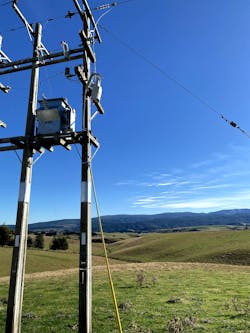New-Generation Reclosers Reduce Outages for Rural Customers
Despite being the larger of the two islands, South Island has about 25% of New Zealand’s 5.1 million inhabitants. The lush vegetation and open space make the island ideal for animal husbandry and agricultural production. These two industries are the leading economic drivers for all of South Island, which has more sheep than people living on it. Still, the local residents have high expectations when it comes to their power delivery.
To serve its more than 70,000 customers effectively and efficiently, PowerNet Ltd. operates one of the country’s largest single-wire-earth-return (SWER) networks. These lines originally were designed in New Zealand nearly 100 years ago as a cost-effective way to bring electricity to rural communities. Because of their simple construction and low cost when compared to two- and three-phase systems, the SWER line design is still preferred across parts of New Zealand and Australia for rural power distribution.
As New Zealand’s fourth-largest investor-owned utility, PowerNet needed to provide excellent customer satisfaction and stay within budget. Because the utility’s customer base was spread throughout a sparsely populated area, the region was vulnerable to frequent outages, resulted in escalating operations and maintenance (O&M) costs. The outages also were a major problem for energy-intensive industries, such as farming, ranching and general manufacturing, that rely on consistent power for businesses to function. For example, an outage impacting a long lateral line could knock out operations for an entire farming community.
Like many utilities, PowerNet was using hydraulic reclosers for protection and fault testing along its SWER lines. However, because its fleet of hydraulic reclosers was aging, the vast majority were disabled to avoid potential catastrophic failures. Because reclosing had been turned off, this led to more frequent outages and resulted in higher O&M costs to operate the lines. And, critical to the community, more customers were without power when faults occurred. Moreover, because the problem areas were impacting approximately 15 farms spread over several miles, they created lengthy delays in restoring power because a single truck roll could take several hours. PowerNet needed a solution that could help it transition away from hydraulic reclosers and meet customer expectations.
Hydraulic Recloser Challenges
When compared to modern vacuum-based SWER line reclosers, hydraulic reclosers have many downsides. Because hydraulic reclosers rely on oil and relatively complex mechanical parts to operate, they can require frequent maintenance and lengthy repairs. Procuring parts when significant repairs are needed can be difficult and expensive, forcing utilities to use spare parts from backup inventory and refurbished units. These expenses can add to the overall operation costs, as having a backup recloser inventory is necessary to meet emergency replacement needs when units fail in the fieldHydraulic reclosers also are susceptible to performance issues when the units’ oil purity and temperature are not properly maintained. This creates ongoing maintenance work for line crews throughout the life cycle of each device. To maintain proper oil quality, line crews must service each unit every three years to five years. If these devices are left unserviced, PowerNet, and other utilities using similar solutions are at risk for compromised reliability and network service, or even more catastrophic failures if the dielectric strength of the oil is compromised.
An additional concern associated with hydraulic reclosers focuses on their protection settings. Hydraulic reclosers and their protection capabilities are mechanically bound, meaning changing the time-current characteristic (TCC) curves of the devices is extremely difficult, especially once a device has been deployed. These mechanical limitations mean only three or four fixed TCC curve options will work with hydraulic devices.
The most common solutions utilities use to make TCC curve changes include routinely taking hydraulic reclosers off the line to be reconfigured or building up a significant inventory of spare hydraulic reclosers, accounting for multiple TCC curve profiles, and swapping out devices as necessary. While these approaches work, they add significant O&M costs to the utility’s bottom line.
Deploying a New Solution
PowerNet was interested in reducing the O&M costs associated with its hydraulic reclosers, so it began exploring other overhead solutions that would require less maintenance, reclose up to four times, reduce inventory requirements and, ultimately, decrease the number of outages — while also maintaining the same protection-operation characteristics found in hydraulic devices.
S&C’s TripSaver II Cutout-Mounted Recloser met all PowerNet’s requirements. The device’s primary key features were its easy installation and minimal maintenance requirements throughout its service life. The utility also would benefit from the cutout-mounted reclosers’ adaptability and configuration options.
Unlike hydraulic reclosers, which are fixed mechanical devices, TripSaver II reclosers are user configured and contain a microprocessor-based relay that gives utilities exact TCC curves and improved coordination capabilities, including fuse-saving features. In addition, the reclosers’ smart capabilities include data logging, which would enable PowerNet to better analyze events and optimize its system. Using the reclosers also meant the utility could reduce inventory costs, trim annual maintenance expenses, and allow crews to avoid multi-hour road trips for outages.
Recognizing how the cutout-mounted reclosers could improve reliability in its most remote locations, PowerNet moved forward with an initial trial of six reclosers. Designed for easy adoption with existing infrastructure, the devices are installed and operated like a fuse and do not require separate power or control modules. Like legacy fuses, these reclosers visibly drop out of the cutout mount when a permanent fault occurs, making it easier for line crews to recognize the location of the fault. Because these automated devices offer more TCC curves and are configurable from 4 A to 200 A, PowerNet was able to achieve the flexibility it lacked from using hydraulic reclosers.
In addition to the advanced protection, the cutout-mounted recloser design enabled PowerNet to rapidly deploy them. Designed to fit into fuse cutout mounts to ease the transition for line crews, the reclosers also can use the same TCC curves previously used for conventional fuses and hydraulic reclosers on the system. The flexibility and accuracy of these devices made for an easy deployment.
Considering all the benefits of an installation, PowerNet believed the cutout-mounted reclosers would improve reliability and enable the utility to serve customers in the most remote locations better.
The Results
Based on the initial success of the pilot project, PowerNet decided to increase the number of devices deployed throughout its power grid. Composed of roughly two dozen units, the expanded trial has saved the utility more than 120 avoided truck rolls. By successfully keeping temporary faults from becoming permanent outages, the cutout-mounted reclosers are improving power reliability on their respective lines and contributing to a swift return on investment for PowerNet.
Based on these clear benefits, PowerNet further expanded the trial. A total of 65 TripSaver II reclosers will be installed across all its SWER lines over the next few years. When the devices are fully deployed, PowerNet expects to save approximately 520 truck rolls and more than 1000 crew hours per year on avoided fault-management tasks. The use of these reclosers already has resulted in a significant reduction in the utility’s O&M costs when compared to the cost of using and maintaining conventional hydraulic reclosers.
Jaques Vergottini, PowerNet’s lead project manager, said: “The S&C TripSaver II recloser deployment is projected to save us 10 truck rolls per week, resulting in a significant reduction in O&M costs vs. conventional hydraulic reclosers. More importantly, it means improved reliability for our customers located in the most remote areas of our system.”
Jason Lander joined S&C Electric Co. in 2008 in the Europe, Middle East, and Africa (EMEA) regional office after spending more than 12 years working in the power-generation and petrochemical sector. In 2013, he moved to S&C’s Asia-Pacific business unit in Melbourne to establish the local power systems solutions group. Lander studied mechatronics and electrical engineering at the University of Glamorgan in South Wales, United Kingdom. He is a member of the Institution of Engineering and Technology (IET) and the Australian Institute of Directors. Lander has presented at IET, the American Wind Energy Association (AWEA) conference, and various smart grid and energy storage conferences. He also has coauthored numerous industry technical papers.
For More Information
S&C Electric Co. | www.sandc.com
About the Author
Jason Lander
Jason Lander joined S&C Electric Co. in 2008 in the Europe, Middle East, and Africa (EMEA) regional office after spending more than 12 years working in the power-generation and petrochemical sector. In 2013, he moved to S&C’s Asia-Pacific business unit in Melbourne to establish the local power systems solutions group. Lander studied mechatronics and electrical engineering at the University of Glamorgan in South Wales, United Kingdom. He is a member of the Institution of Engineering and Technology (IET) and the Australian Institute of Directors. Lander has presented at IET, the American Wind Energy Association (AWEA) conference, and various smart grid and energy storage conferences. He also has coauthored numerous industry technical papers.



